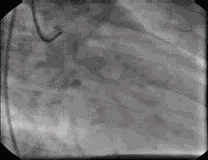This was an R&R recommendation via Ryan so go read his take on it, which is roughly the same just written much better…

- prospective data from Paris in a large centralised system
- OHCA attended by the mobile ICUs that include physicians
- brought to a cardiac arrest centre
- they say that OHCA without an obvious other cause “usually” got an immediate angio – This is the key phrase in the whole paper as i have no idea what “usually” means. And I’m also not sure what they mean by obvious cause.
- PCI and ICU care was standard and involved hypothermia but they don’t tell us much else about the details
- primary outcome was detection of a recent coronary occlusion – again I’m not sure what this means; they reference a couple of papers but I don’t know if they’re the standard definitions for the PCI literature. I’m just sharing my ignorance here so let me know if you know better.
- Interestingly this is not what you would expect given the title of the paper. If the purpose is to identify occlusions then fine, but it seems that the purpose is to associate Trop with occlusion in OHCA patients. It’s not clear but it may be that they just applied logistic regression and the trop was the one that popped up.
RESULTS
- recorded 435 in 5 years. That strike me as dodgy – if OHCA usually get an angio in this system then these are tiny numbers for 5 years worth of cardiac arrests. it seems much more likely that this is a highly selected sample.
- 30% of these were STEMI on ECG and so would have got cath anyway hopefully
- of those who got cath they only stented/opened <50%
- trop was +ve in 92% of the pts
- they pull the numbers on trops and come up with the optimum cut-off of 4.66ng/ml with (wait for it…) sens and spec of 67%…. Sigh
- much more interestingly STEMI on ECG was 50% sens and 90% spec for occlusion
- survival 40% overall in this cohort
- they conclude that troponin it’s independently contributive but then pull back and acknowledge the problem that it’s no where near good enough to make calls on.
- they also note the previous (tiny) papers showed much more favourable numbers for cut offs for trop in OHCA
Dumas, Florence, Stéphane Manzo-Silberman, Jérôme Fichet, Zohair Mami, Benjamin Zuber, Benoît Vivien, Camille Chenevier-Gobeaux, et al. “Can Early Cardiac Troponin I Measurement Help to Predict Recent Coronary Occlusion in Out-of-Hospital Cardiac Arrest Survivors?.” Critical Care Medicine (April 6, 2012). PMID 22488008

Kind of makes sense though. Troponin leaks noly indicate the ocurence of myocardial damage, severe enough to cause intracellular contents to leak across the membrane; e.g. necrosis. But you don’t need an occlusive lesion to cause ischaemic damage. Severe vasospasm is enough (cocaine). You don’t even need any form of coronary vessel narrowing. Tachyarrythmias will lift the TnT level, as will cardioversion and sepsis.
Which cohort exactly showed a 40% survival following OHCA? Is it me or is that a quite astounding outcome for any group following arrest?
The “which cohort exactly” is not answered in the paper. The cohort was OHCA without “obvious non-cardiac cause” which is too slippery a definition to be of any use.
They only got 400 its over 5 years from a system serving 5 million people so there must be a huge denominator not recorded here.
70% were a shockable rhythm so maybe with really good selection you might be able to get a survival rate of 40%.